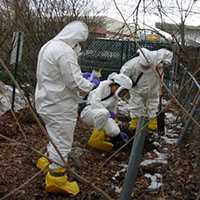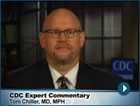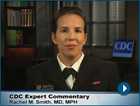Outbreaks and Investigations

Disease detectives collecting soil samples to test for fungus
When fungal disease outbreaks occur, CDC’s Mycotic Diseases Branch works with federal, state, and local and territorial public health officials and other partners to reduce illness and deaths and to learn how to prevent future outbreaks.
Fungal outbreaks have been linked to a variety of sources, including exposure to disease-causing fungi in the natural environment or injections with contaminated medication. With systems in place for early identification for these types of events, CDC and partners can continue to track, test for, respond to, and better understand emerging fungal health threats.
Some fungal diseases may be more common than previously realized, and rare but newly-emerging fungi are becoming increasingly problematic. Some types of fungal infections can be deadly if they are not identified and treated quickly, so early recognition is essential in order to reduce the risk of serious complications and save lives.
Recent Fungal Outbreaks and Investigations
Histoplasmosis in the Dominican Republic
Histoplasmosis outbreak among tunnel workers in the Dominican Republic, September 2015.
- Number of cases: 30
- Pathogen: Histoplasma capsulatum
- Type of infection: pulmonary
- Setting: tunnels used for access to a hydroelectric dam
- Source: related to disruption of soil contaminated with bat droppings
- Outbreak investigation partners: Dominican Republic Ministry of Health and NIOSH
- Resources
- Stories from the Field: Disease Detectives Investigate a Histoplasmosis Outbreak in the Dominican Republic
Fatal Gastrointestinal Mucormycosis in an Infant
- CDC, FDA, and state health departments investigated a fatal case of gastrointestinal mucormycosis caused by Rhizopus oryzae in a premature infant in October 2014. Infection followed the use of ABC Dophilus Powder, a dietary supplement purchased from Solgar, Inc., Leonia, NJ.
- Testing of the same lot of unopened Solgar ABC Dophilus revealed contamination with Rhizopus oryzae.
- Solgar has voluntarily recalled lots 074024-01R1, 074024-01, 074024-02 (expiration date 7/31/15).
- For more information about this investigation please visit the Fungal Rhizopus Investigation web page.
Histoplasmosis in an Illinois Prison
Histoplasmosis outbreak at a state prison in Illinois, August – September 2013
- Number of cases: 78
- Pathogen: Histoplasma capsulatum
- Type of infection: pulmonary
- Setting: adult prison in east-central Illinois
- Source: likely related to disruption of soil contaminated with bird droppings
- Outbreak investigation partners: Illinois Department of Public Health and Illinois Department of Corrections
Coccidioidomycosis (Valley fever) in California Prisons
High rates of coccidioidomycosis (Valley fever) at two state prisons in California's Central Valley, June 2013
- Pathogen(s): Coccidioides
- Type of infection: mostly pulmonary
- Setting: Two prisons in California’s Central Valley
- Source: Natural environment
- Outbreak investigation partners: California Department of Public Health, California Correctional Healthcare Services, and California Department of Corrections and Rehabilitation
- Resources and publications
Valley Fever: Diagnosis and Treatment

July 24, 2013
CDC expert Dr. Benjamin Park talks to clinicians about diagnosis and treatment of valley fever, a respiratory infection caused by inhaling the airborne spores of the fungus Coccidioides.
More Information about Valley Fever
Valley Fever Fact Sheet [PDF - 2 pages]
Fungal meningitis after contaminated steroid injections
Multistate outbreak of fungal meningitis and other fungal infections associated with contaminated steroid injections, October 2012
For more details about this investigation, please see the Multistate Fungal Meningitis Outbreak Investigation page.
- Number of cases: 753
- Pathogen(s): Exserohilum rostratum and others
- Type of infection: Meningitis, localized spinal or paraspinal infections, and infections in a peripheral joint space, such as a knee, shoulder, or ankle
- Setting: Outpatient clinics in 20 states
- Source: Contaminated steroid injections from a compounding pharmacy
- Outbreak investigation partners: State and local health departments and the U.S. Food and Drug Administration
- Selected publications
- Bell BP, Khabbaz RF. Responding to the Outbreak of Invasive Fungal Infections: The Value of Public Health to Americans. JAMA. 2013;():1-2. doi:10.1001/jama.2013.526.
- Smith RM, Schaefer MK, Kainer, MA, et al. Fungal infections associated with contaminated methylprednisolone injections – Preliminary Report. New Engl J Med 2012 Dec.
- Kainer MA, Reagan DR, Nguyen DB, et al. Fungal infections associated with contaminated methylprednisolone in Tennessee. New Engl J Med 2012 Nov.
- Lyons JL, Gireesh ED, Trivedi JB, et al. Fatal Exserohilum meningitis and central nervous system vasculitis after cervical epidural methylprednisolone injection. Ann Intern Med 2012 Oct.
- Pettit AC, Kropski JA, Castilho JL, et al. The index case for the fungal meningitis outbreak in the United States. New Engl J Med 2012 Oct.
Fungal Infection Outbreak: What Should Physicians Be Doing?

October 31, 2012
CDC expert Dr. Tom Chiller provides clinical guidance related to the multistate fungal meningitis outbreak among patients who received contaminated steroid injections.
Fungal endophthalmitis after contaminated injections
Multistate outbreak of postprocedural fungal endophthalmitis associated with products from a single compounding pharmacy, March 2012
- Number of cases: 43
- Pathogen(s): Fusarium incarnatum-equiseti species complex (a colorless mold) and Bipolaris (a black mold)
- Type of infection: Endophthalmitis (an infection in the interior of the eye)
- Setting: Outpatient facilities in 9 states
- Source: Contaminated triamcinolone and Brilliant Blue-G dye from a compounding pharmacy
- Outbreak investigation partners: State and local health departments and the U.S. Food and Drug Administration
- Resources and publications
- CDC. Notes from the Field: Multistate Outbreak of Postprocedural Fungal Endophthalmitis Associated with a Single Compounding Pharmacy—United States, March–April 2012. MMWR 2012;61:310.
- Mikosz CA, Smith RM, Kim M, Tyson C, Lee EH, Adams E, et al. Fungal endophthalmitis associated with compounded products. Emerg Infect Dis 2014; 20:248-256.
Fungal Endophthalmitis: Diagnosis and Treatment

November 12, 2012
CDC expert Dr. Rachel Smith discusses diagnosis and treatment of fungal endophthalmitis, an inflammation in the intraocular cavities of the eye.
Mucormycosis after a natural disaster
Outbreak of mucormycosis after the Joplin, Missouri tornado, May 2011
- Number of cases: 13
- Pathogen(s): Apophysomyces trapeziformis
- Type of infection: Soft-tissue
- Setting: Joplin, Missouri
- Source: Natural environment after a tornado
- Outbreak investigation partners: Missouri Department of Health and Senior Services, University of Texas Health Science Center, and the Translational Genomics Research Institute
- Resources and publications
- CDC’s Public Health Matters Blog
- CDC. Notes from the Field: Fatal Fungal Soft Tissue Infections after a Tornado—Joplin, Missouri, 2011. MMWR 2011;60:992.
- Fanfair RN et al. A Large Outbreak of Necrotizing Cutaneous Mucormycosis Following a Tornado, Joplin Missouri, 2011. New Eng J Med 2012; 367:2214-2225.
- Etienne K et al. Whole genome sequence typing to investigate the Apophysomyces outbreak following a tornado in Joplin, Missouri, 2011. PLoS One. 2012;7(11):e49989.
Mucormycosis: When to Think Fungal Infection

October 3, 2012
CDC expert Dr. Benjamin Park explains to clinicians when to suspect fungal infections.
More Information about Mucormycosis
Murcormycosis Fact Sheet [PDF - 1 page]
Blastomycosis in Wisconsin
Outbreak of blastomycosis, Marathon County, Wisconsin, 2010-2011
- Number of cases: 55
- Pathogen(s): Blastomyces dermatitidis
- Type of infection: Mostly pulmonary
- Setting: Marathon County, Wisconsin
- Source: Likely multiple foci in the natural environment
- Outbreak investigation partners: Marathon County Health Department, Wisconsin Department of Health Services, Marshfield Clinic Research Foundation, and the University of Wisconsin
- Resources and publications
- Roy M et al. A Large Community Outbreak of Blastomycosis in Wisconsin with Geographic and Ethnic Clustering. Clin Infect Dis 2013; 57:655-662.
Trichosporon among ICU patients in Jamaica
Trichosporon among intensive care unit patients, Kingston, Jamaica, 2010
- Number of cases: 63
- Pathogen(s): Trichosporon asahii
- Type of infection: Colonization and invasive disease
- Setting: Hospital in Kingston, Jamaica
- Source: Likely contaminated washbasins
- Outbreak investigation partners: Jamaica Ministry of Health
- Resources and publications
- Fanfair RN et al. Trichosporon asahii among intensive care unit patients at a medical center in Jamaica. Infect Control Hosp Epidemiol 2013; 34:638-641.
Mucormycosis associated with hospital linens
- Number of cases: 5
- Pathogen: Rhizopus delemar
- Type of infection: Cutaneous
- Setting: Pediatric hospital in Louisiana
- Source: Hospital linens
- Outbreak investigation partners: Louisiana Department of Health and Hospitals
- Publications:
- Duffy J, Harris J, Gade L, Sehulster L, Newhouse E, O'Connell H, et al. Mucormycosis Outbreak Associated with Hospital Linens. Ped Infect Dis J. 2014; 33(5):472-6
- Page last reviewed: January 27, 2017
- Page last updated: January 27, 2017
- Content source:


 ShareCompartir
ShareCompartir